Disposable transfusion sets are designed with several features to minimize the risk of air embolism during transfusion, which is crucial for patient safety. Here are some key design considerations:
Air Filters: Transfusion sets often incorporate air filters or air-inlet valves at critical points in the tubing. These filters trap any air bubbles that may enter the system, preventing them from reaching the patient's bloodstream.
Air Detection Mechanisms: Some advanced transfusion sets include air detection mechanisms that can automatically detect and alarm when air bubbles exceed safe levels. This alerts healthcare providers to take corrective action before it poses a risk to the patient.

Closed System Design: The entire transfusion set is designed as a closed system, minimizing opportunities for air to enter. This includes secure connections between components and tubing that is resistant to kinking or accidental disconnection.
Prime Tubing: Before initiating the transfusion, healthcare providers typically "prime" the tubing with saline or a compatible solution. This process removes any air from the tubing and ensures that only the blood or blood component reaches the patient.
Clear and Transparent Tubing: Tubing used in transfusion sets is often transparent or translucent, allowing healthcare providers to visually inspect for air bubbles during the transfusion process.
Training and Protocols: Proper training for healthcare providers on the correct setup and use of transfusion sets is essential. This includes protocols for monitoring the infusion process and responding to any alarms or deviations from normal operation.
By integrating these design features and following strict protocols, disposable transfusion sets help to significantly reduce the risk of air embolism during blood transfusion procedures, ensuring patient safety and care.

 English
English 中文简体
中文简体








